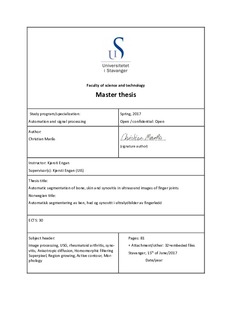| dc.contributor.advisor | Engan, Kjersti | |
| dc.contributor.author | Marås, Christian | |
| dc.date.accessioned | 2017-09-21T07:39:34Z | |
| dc.date.available | 2017-09-21T07:39:34Z | |
| dc.date.issued | 2017-06-15 | |
| dc.identifier.uri | http://hdl.handle.net/11250/2455889 | |
| dc.description | Master's thesis in Cybernetics and signal processing | nb_NO |
| dc.description.abstract | Rheumatoid arthritis (RA) is estimated to affect between 0.3 to 1.5 % of the population. It tends to strike individuals between the ages of 35-50, which is their working age, with every third individual diagnosed with RA becoming work disabled, and up to 85% of the individuals who still can work losing almost 40 days per year on average. Therefore, an accurate measurement of disease activity is crucial to provide adequate treatment and care for patients. The first stage in RA is inflammation of the synovial membrane which is called synovitis. Using ultrasonography has proven to provide useful information regarding the disease activity. The assessment of disease activity has until now been done visually by doctors by grading the synovitis from 0-3 in the ultrasound images. Making a software to automate these assessments in order to reduce the number of human-dependent discrepancies can be advantageous.
Materials given in this thesis came from the Norwegian and Polish collaborative project, MEDUSA. They included ultrasound images of finger joints and manually annotated data which was used for similarity measurement. The objective of this thesis has been to segment the synovitis in the ultrasound images automatically. Since it develops from the joint area towards the skin, it was nec-essary to segment skin and bones first. Multiple image processing techniques were tested for the proposed system for segmentation of bone skin and synovitis. Novel methods for segmentation and location of these features were also developed. All the proposed methods were implemented using MATLAB.
The similarity measurement was done by computing the modified Hausdorff distance for bone and skin, whereas the Dice coefficient was used for comparing the synovitis with the annotation data. The results show that the proposed system for segmentation of bone and skin functioned well with 80% of the segmented bone and skin features having a distance under 20px to the annotation data. However, one of the two bones had only 55% under 20px, but had a median of 11px. The proposed system for segmentation of the synovitis gave an overall low Dice coefficient, with the best result giving a median and mean Dice of 58 and 54 respectively using Region growing. However, when inspecting the images visually, most of the segmented synovitis seemed descent.
It was concluded that even though the skin and bone segmentation was good, the proposed methods for segmentation of the synovitis did not yield satisfactory results for future grading of it. | nb_NO |
| dc.language.iso | eng | nb_NO |
| dc.publisher | University of Stavanger, Norway | nb_NO |
| dc.relation.ispartofseries | Masteroppgave/UIS-TN-IDE/2017; | |
| dc.rights | Navngivelse 4.0 Internasjonal | * |
| dc.rights | Navngivelse 4.0 Internasjonal | * |
| dc.rights.uri | http://creativecommons.org/licenses/by/4.0/deed.no | * |
| dc.subject | informasjonsteknologi | nb_NO |
| dc.subject | automatisering | nb_NO |
| dc.subject | signalbehandling | nb_NO |
| dc.subject | bildebehandling | nb_NO |
| dc.subject | image processing | nb_NO |
| dc.subject | revmatoid artritt | nb_NO |
| dc.title | Automatic segmentation of bone, skin and synovitis in ultrasound images of finger joints | nb_NO |
| dc.type | Master thesis | nb_NO |
| dc.subject.nsi | VDP::Teknologi: 500::Informasjons- og kommunikasjonsteknologi: 550::Teknisk kybernetikk: 553 | nb_NO |

